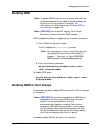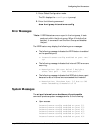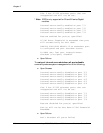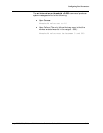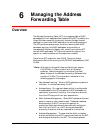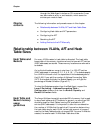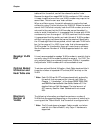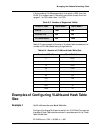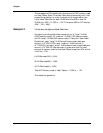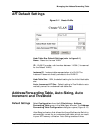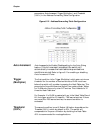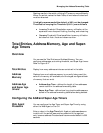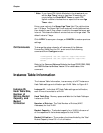
Avaya P550R, P580, P880, and P882 Multiservice Switch User Guide, Version v5.3.1 6-3
Managing the Address Forwarding Table
It is not advised to allow the total hash table memory usage to
exceed 20K. More than 20K will limit the potential for growth (i.e.,
address learning). If your Avaya Multiservice switch is approaching
this threshold, adjust the Initial Hash Table Size accordingly.
For example, if you anticipate creating more than 20-30 VLANs, the
Initial Hash Table Size default setting must be reduced. The rule of
thumb is the following formula:
Number of VLANs times Initial Hash Table Size <20K
Example 1: 30 x 512 ~ 15K
Example 2: 1000 x 16 ~ 16K
* Note: When you create a VLAN, there are 18 internal MAC
entries automatically created for that VLAN. If you were
to configure Example 2, the switch would indicate that
36K of memory is currently in use. This is because you
have 16K of memory for the VLAN Hash Tables and
another 20K of memory used for the 18,000 MAC
entries.
Hash Table guidelines for creating VLANs
Maximum
Number of
VLANs
In order to support the maximum number of VLANs, VLAN ID
numbers should be chosen from the range of 1 to 1000. The
numbering of VLANs has no impact on memory usage within the
switch. The numbering of VLANs only effects the total number of
supported VLANs. This is not a memory usage issue, however, it
does effect the way the switch uses or Hashes VLAN ID’s. If VLAN
ID’s are used outside of the range of 1 to 1000, there is a possibility
of unavailable VLAN ID’s. This again does not effect switch memory
usage. If VLANs are already created with VLAN ID’s outside of the 1-
1000 range, there is no need to reassign new VLAN ID’s. The only
potential issue could be particular VLAN ID’s might not be available.
VLAN ID
number outside
the
recommended
range
If you use an ID number outside the range of recommended
numbers, you may find certain VLAN ID numbers cause “collisions”
and are unavailable when you try to create a new VLAN.
The reason for this has to do with the way that the switch hashes
VLAN numbers into internal tables. The ‘hash’ algorithm used by
the switch takes VLAN numbers (which have a range from 1 to
4094) and ‘hashes’ them to a range of 1 to 1024 by picking 10 bits
from the VLAN number. This smaller range is used as an index into



